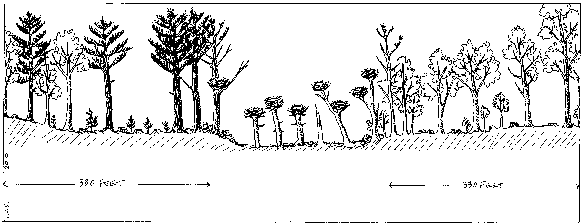Recommended Voluntary Forest Management Practices for New Hampshire
6.12 HERON COLONIES
BACKGROUND
Herons nest in colonies (colonial nesters) in mature trees in or near wetlands. Nesting birds tend to be very sensitive to human disturbance.
Great blue herons are large wading birds that nest in colonies of several to many pairs. Nesting colonies usually are found near wetland and shoreline feeding areas, though they occasionally will nest at some distance from wetland feeding areas. Most southern New Hampshire nests occur in dead trees in beaver ponds. North Country nests are usually in live white pines that tower above the surrounding treetops. Heron colonies also may occur in mature live hardwoods on upland sites. Heron colonies come and go over time; often as nesting snags fall and trees lose their branches or as a nearby food source changes.
Human activity in the vicinity of a nesting colony during the breeding season may lead to low productivity or abandonment; distance from human settlements appears to be a significant factor in colony site selection. Great blue herons will flush from nests in response to intrusions at distances of roughly 400 to 600 feet early in the breeding season (April through May) before incubation has begun, and at distances of roughly 100 to 300 feet during incubation and nestling periods.
OBJECTIVE
Prevent disturbance or loss of heron nesting colonies.
CONSIDERATIONS
- Information on location and numbers of great blue heron colonies across the state is lacking. Most of the known colonies are located south of the White Mountains.
- Great blue herons are protected, as are all migratory birds, under the federal Migratory Bird Act of 1918.
- Given the short sight distances of the birds and the dynamic nature of nesting colonies in the northeast, past recommended buffers appear to be larger and more restrictive than needed to protect heron colonies.
- Road construction in the vicinity of a nesting colony may result in nest abandonment. Nesting herons may tolerate vehicle traffic on existing roads, but pedestrians visible from nests often present more of a problem than traffic.
RECOMMENDED PRACTICES
- Within roughly 330 feet (5 chains) of an active, occupied heron colony:
- Refrain from cutting live or dead nest trees.
- Locate roads and trails outside the buffer. If not possible, avoid road construction, harvesting, and recreational activity during the breeding and nesting season (April through August).
- Limit harvest activity to single tree or small group selection harvests outside the breeding and nesting season.
- Increase the buffer distance if conditions make it likely that nesting birds might be disturbed beyond the 330 foot buffer.
- Report heron-colony locations to the Nongame and Endangered Wildlife Program at N.H. Fish and Game or NH Bird Records.

CROSS REFERENCES
4.2 Wetlands; 4.3 Forest Management in Riparian Areas; 6.8 Beaver-Created Openings.
ADDITIONAL INFORMATION
Elliott, C.A. 1988. A Forester's Guide to Managing Wildlife Habitats in Maine. University of Maine Cooperative Extension, Orono, Maine.
Migratory Bird Act of 1918. http://www.fws.gov/laws/lawsdigest/migtrea.html Accessed on February 23, 2010.
N.H. Bird Records. http://www.nhbirdrecords.org Accessed on February 23, 2010.